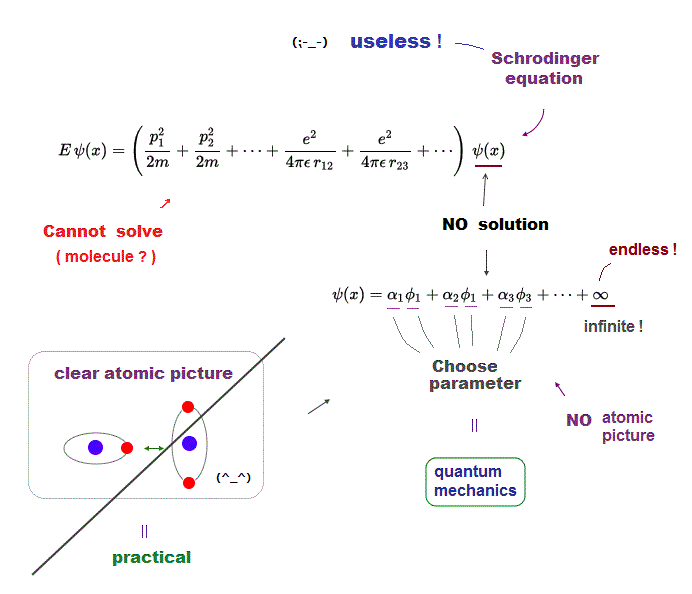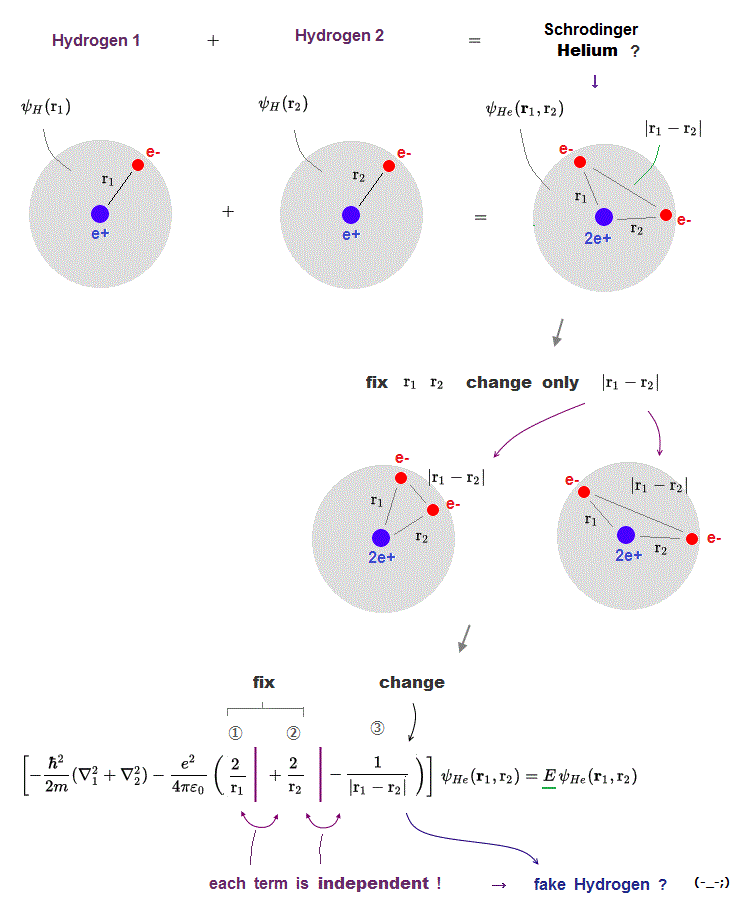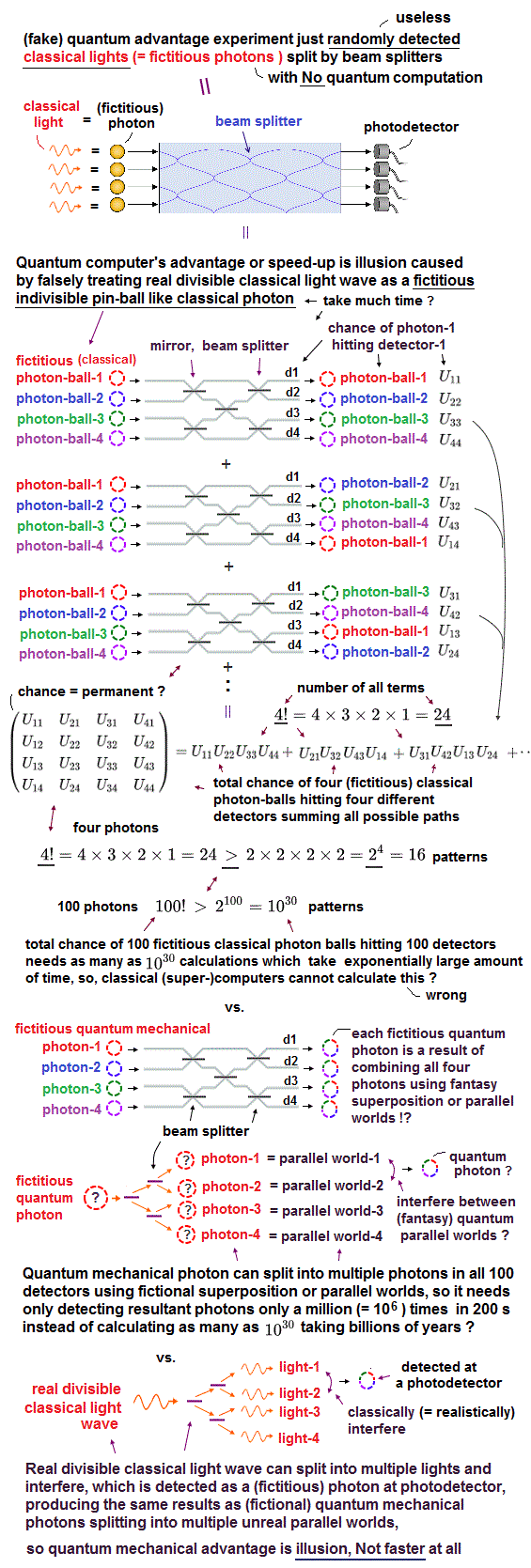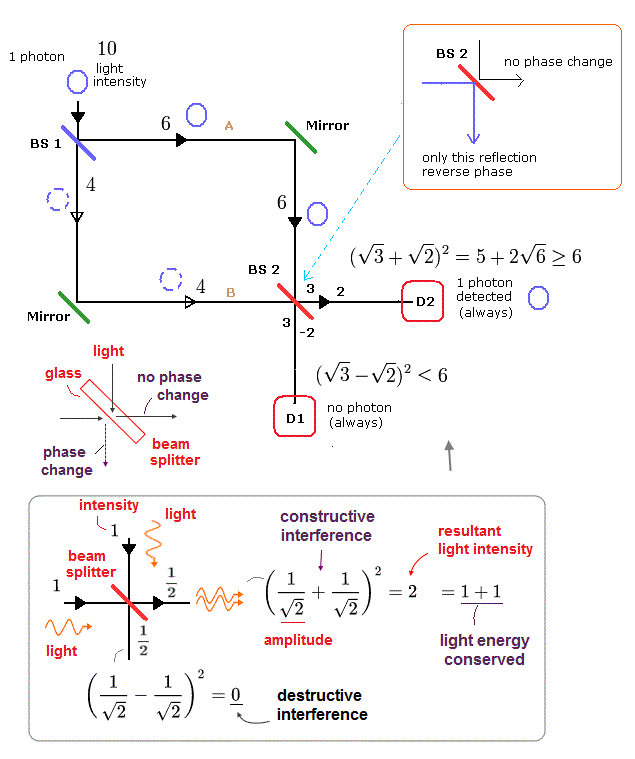
Home page
Quantum computer is useless
Quantum supremacy is fake
(Fig.1) Quantum computer advantage is useless, just detecting random photons without quantum computation nor error correction.

The overhyped claim that Chinese and Canadian Xanadu's photon quantum computers might have showed quantum advantage (= supremacy ) over ordinary classical computers is false, based on wrong assumption or useless random photon detection called gaussian boson sampling (= GBS ).
This-p.1-right-last-paragraph (or this-p.2-last-paragraph ) on (fake) quantum advantage experiment says -- Random photon detection
" Boson sampling,.. was the first feasible protocol for quantum computational advantage....,
non-classical light (= false, a photon is just classical weak light ) is injected into a linear optical network,
and in the output highly random, photon-number-.. is measured by single-photon detectors."
First of all, photons or weak classical lights are too easily lost (= too many errors ), so photon's quantum computers consisting of only beam splitters and photodetectors can never become reality, let alone showing advantage.
This fake overhyped photon quantum computer's advantage experiments detecting photons (= weak lights ) randomly (= called gaussian boson sampling = GBS ) without any computation nor error correction is useless, of No practical application ( this 3rd-last-paragraph, this-last-paragraph, this-2nd-3rd-paragraphs ).
This 3rd-last paragraph (8/22/2025) says -- No quantum computer
"the quantum computer cannot be programmed to carry out just any calculation.... it (= fake quantum advantage ) lacks crucial elements for fault-tolerant and useful quantum computation," ← So these useless fake quantum advantage experiments cannot even correct error nor get right answers ( this-introduction-1st-paragraph ). ← Not even quantum computers
This-last-paragraph says -- No practical use
"quantum computers have a long way to go. GBS (= gaussiabn boson sampling for fake quantum advantage ) has No practical applications and finding a practical use for quantum chips in their current form is difficult. "
The 9th, 12th paragraphs of this hyped news say -- No quantum advantage
"Photons are sent into the network (one at each input) and exit in a state that is randomly chosen from all possible states."
"that is mostly useless.. this is why the researchers do Not refer to the device as a computer—... And for these cases, we have Not yet seen undisputed evidence of the promised quantum advantage."
This-p.6-cons say -- Fake useless advantage
"No error-correction (= so this fake quantum advantage experiments based on boson sampling just give wrong erroneous random numbers ), so theory still far from experimental reality; Hard to verify that device is doing what it should; No practical applications"
This-p.2-right-1st-paragraph says -- Just random detection
"the Boson sampling result
is a superposition state before the photon output
detection that the output is random and independent of the input source" ← Just detecting photons randomly is Not quantum computation.
This 8th-paragraph-caveats says -- Useless advantage
"the problems they are solving are experiments – the results are, for lack of a better word, useless."
The last paragraph of this site says -- No practical use
"neither Jiuzhang (= Chinese photon quantum computer ) nor Google’s superconductor-based prototype can be applied to real-world problems" ← useless ( this last-paragraph ).
↑ The fact that we still do Not use these (useless) quantum computers in our daily life means these quantum advantage and supremacy are fake.
This p.2-left-1st-paragraph says -- No quantum advantage
"Boson sampling,.. These sampling
problems also lie at the basis of the random circuit sampling
protocol, which would lead to the first experimental
claim of a quantum computational advantage. However,
in a game of constantly shifting goal posts, this claim has
already been challenged" ← Quantum advantage turned out to be false and illusion.
In these fake quantum advantage experiments, physicists just sent multiple photons (= or weak lights ) into multiple beam splitters, and detected the output photons at multiple photodetectors randomly with No meaningful computation.
This 3rd-paragraph says
"The problem consists of sampling from the output distribution of detection events generated when many single photons are concurrently injected into a randomly chosen network of linear optical components (= beamsplitters ). "
(Fig.2) A (fictional) classical indivisible photon (= classical computer ? ) can take only one path to be detected by photodetector, while a quantum photon can take multiple paths simultaneously by illusory unseen quantum superposition or parallel universes, which is quantum advantage ? No.

In these fake quantum advantage experiments based on useless boson sampling, they falsely treated classical light wave as a fictional indivisible classical photon ball (in Galton's board = classical computer ? ) that cannot split at a beam splitter (= Fig.2-upper ).
↑ So they say this fictional indivisible classical light wave or photon ball cannot imitate nor simulate a quantum photon that can split into two paths at a beam splitter ( this p.32-Figure 1.9 ) by utilizing ( illusory ) quantum superposition or parallel universes, which may indicate (fake) quantum advantage ( this 3~4th-paragrpahs, Fig.2-lower ) ! ← nonsense.
This 7th-paragraph says -- Photons = superposition ?
"Photons are first sent into a network of channels. There, each photon encounters a series of beam splitters, each of which sends the photon down two paths simultaneously, in what's called a quantum superposition ( this scenario )" ← Quantum superposition means a single photon can exist in multiple places simultaneously and unrealistically.
This 4th-paragraph says -- Photons = parallel worlds ?
"However, while these distinguishable classical balls (= indivisible classical photons ) take familiar, distinct paths down the board, rolling either left or right off of each peg they encounter, the ( divisible quantum ) photons in some sense collectively take all possible paths (= superposition or parallel worlds ) through their network...
Surprisingly, the interference of these paths makes it hard for a classical computer to predict"
This or this-middle-A light sampling-1st and 4th, 5th paragraphs say
"Instead, the double-slit experiment shows that the photon exists in a superposition, or combination of possibilities, of having gone through both A and B..... allows quantum computers to achieve exponential speedups" ← fiction.
"The setup for boson sampling is analogous to the toy called a bean machine,,,, Balls are dropped into the rows of pegs from the top. On their way down, they bounce off of the pegs and each other until they land in slots at the bottom. Simulating the distribution of balls in slots is relatively easy on a classical computer"
"Instead of balls, boson sampling uses photons, and it replaces pegs with mirrors and prisms. Photons from the lasers bounce off of mirrors and through prisms until they land in a "slot" to be detected. Unlike the classical balls, the photon's quantum properties lead to an exponentially increasing number of possible distributions (= a quantum photon may split into many parallel-universe paths )."
There is No such thing as a classical indivisible light or photon ball in Galton board.
Real classical light wave can split into two paths at each beam splitter and interfere realistically (= without using fictional quantum superposition or parallel worlds ).
As a result, the quantum advantage based on false assumption of the indivisible classical photon treated as a classical computer is illusion, and quantum computers are useless, No quantum advantage.
The recent research showed an ordinary classical laptop computer could simulate (fictional) quantum parallel-world results (= of Xanadu's fake photon quantum computer's advantage randomly detecting photons whose classical simulation was said to take 9000 years ) within minutes (= instead of exaggerated 9000 years ).
The 1st, 11th paragraphs of this say -- No quantum advantage
"developed a method to validate a Gaussian Boson Sampling experiment (= fake useless quantum advantage just randomly detecting photons ), a quantum problem previously estimated to require 9,000 years of classical computation, in just a few minutes on a laptop." ← "Classical (laptop) computers will take 9000 years !" was a lie.
"The experimental data from Borealis (= Xanadu photon quantum computer ) deviated from ideal theoretical predictions (= "ideal" means "calculated by the errorless classical laptop computer" ), revealing inconsistencies between the experimental outputs and the intended quantum model" ← Quantum computers' results were wrong, erroneous, so No quantum advantage.
↑ Quantum advantage proved to be fake, just randomly detecting photons with a lot of errors, while a classical laptop computer can easily simulate the (fictional) quantum photons' ideal parallel world states with No errors.
(Fig.3) Illusory photon's quantum computer's advantage is based on useless tasks called "boson sampling" just detecting random lights or photons with No actual speed-up.

They assumed (fictional) classical light or a photon (= classical computer ? ) that is indivisible at a beam splitter needed extremely much time to calculate the probabilities of many paths taken by an illusory quantum photon that can go through multiple paths simultaneously by using illusory superposition ( this-p.2-right-1st-paragraph ) or parallel worlds.
↑ The point is this (fake) photon quantum computer, which can only randomly detect photons (= lights ), cannot calculate anything nor correct errors, so No real quantum advantage.
They unfairly forced only classical computers to calculate probabilities of all possible parallel-world paths taken by an illusory quantum photon, and estimated this classical photon calculation's time might increase proportional to 2100 where 100 is photon's number ( this-3rd-last-paragrapg ) used in this experiment.
↑ This extremely-time-consuming calculation of summing all probabilities of many paths which a classical photon has to travel to imitate quantum photon's superposition (= unreal parallel universes ) is expressed as "permanent ( this-lower, this p.5-6, this p.19-23, this-middle-a light sampling )"
This-How it works-1st-paragraph says -- Parallel worlds = permanent
"In a boson sampling device, we have M identical photons entering N input ports of a linear optical circuit... Because photons are bosons, their quantum amplitudes add coherently over all possible permutations of which output ports they could land in.
"When we measure how many photons ended up in each output mode, the probability of a specific detection pattern is given by the squared magnitude of a permanent of an M×M submatrix of the unitary matrix describing the interferometer. Intuitively, each term in the permanent corresponds to one way the photons could propagate through the network and bunch among outputs, and because they are indistinguishable bosons, all those pathways (= of illusory parallel worlds ) interfere positively... Computing a permanent of a large matrix is a notorious #P-hard problem, which is why sampling from this distribution is believed to be classically intractable for large M."
If we replace the indivisible classical photon ball by the divisible classical light wave, this quantum advantage disappears.
↑ There is No such thing as an indivisible classical photon ball or a quantum photon divisible by (unseen) superposition.
Only divisible classical light wave exists in this world, so No quantum advantage from the beginning.
Even when a classical method was unfairly forced to conduct this extremely-time-consuming calculation of many light paths based on the fictional indivisible classical photon imitating quantum photon's superposition or parallel worlds, the classical computer could outperform the photon quantum computer after all ( this 2nd-paragraph ).
This-lower conclusion says -- Classical better
"introduced a classical algorithm that accurately simulated Gaussian boson sampling, outperforming some quantum experiments. This work questioned the claimed quantum advantage" ← officially, No quantum advantage.
So there is No quantum advantage after all in today's quantum computers which are too error-prone to give right answers.
(Fig.4) Fake quantum advantage is based on illusory quantum interference called Hong-Ou-Mandel effect where two photons (= two lights ) magically stick to each other at a beam splitter, which can be explained by classical light interference, so No quantum advantage

The fake quantum advantage is based on the false assumption that only a (illusory) quantum photon can split and interfere at beam splitters though (fantasy) quantum superposition or parallel universes.
When two photons (= two lights ) enter a beam splitter simultaneously, these two photons or lights may exit the beam splitter on the same side, as if they appear to stick to each other ( this-16th-paragraph, this 3rd-paragraph ), which is called Hong-Ou-Mandel (= HOM ) effect ( this 5th-paragraph, this 2nd-paragraph ) allegedly involving quantum superposition.
↑ This Hong-Ou-Mandel effect can be naturally explained by interference of classical light wave at beam splitter (= the phase of the light reflected by one side of a beam splitter does not change, and the phase of the light reflected by the other side of the beam splitter becomes the opposite ). ← Only light exiting one side of the beam splitter, whose light amplitude constructively interferes and surpasses photodetector's detection threshold, is detected as a (illusory) photon ( this p.5-p.7, ), which appears as if two lights stick to each other at a beam splitter..
↑ This p.6-right-1st-paragraph says phases of two photons (= weak lights ) are random, hence, only the light existing from one (random) side of the beam splitter, whose light amplitude surpasses the photodetector's threshold by (partial) constructive interference between two lights (= in a classical wave ), is detected as a (illusory) photon at the photodetector, while the light exiting the other side of the beamsplitter, whose amplitude is (partially) destructively interfered, cannot be detected as a photon (= two photons stick quantum mechanically ? No ).
↑ So their alleged quantum interference called HOM effect (= two photons magically stick to each other at beam splitter !? ) can be naturally explained by the ordinary classical light interference, hence No quantum advantage from the beginning.
This is why the current (fake) quantum computer advantage is useless.
The 2nd, 3rd, 6th, paragraphs of this overhyped news(6/25/2025) say
"Their approach uses just three photons (= just 3 photon qubits = 001 is still Not a quantum computer nor outperform a classical computer ) and a linear optical network, marking a significant step towards (= still unrealized ) low energy quantum AI systems."
"In boson sampling, researchers inject single photons into one such circuit, then measure the output probability distribution after they interfere." ← boson sampling just randomly detecting photons or weak lights has No quantum advantage nor utility, contrary to hypes.
"In their simulated experiment (= Not real experiment, but just classical computer's simulation of photons in this research, so No quantum computer's advantage ), they began by generating a complex photonic quantum state, onto which simplified image data was encoded."
↑ This research paper ↓
p.2-Fig.1 shows this simulation just detected several photons encoding some images (= which photon distribution encoding some images was classified based on some machine learning ) with No quantum computation nor utility.
p.4-left-2nd-paragraph says "numerical simulation (= just classical computer's simulation instead of using real quantum computers, so No quantum computer's advantage in this research )"
p.6-5 conclusion-lower says
"As the size of these QORCs (= quantum linear optical extreme reservoir computing ) increases,
they should (= just speculation, still unrealized ) be able to perform classification tasks that are challenging in today’s machine learning world"

Feel free to link to this site.